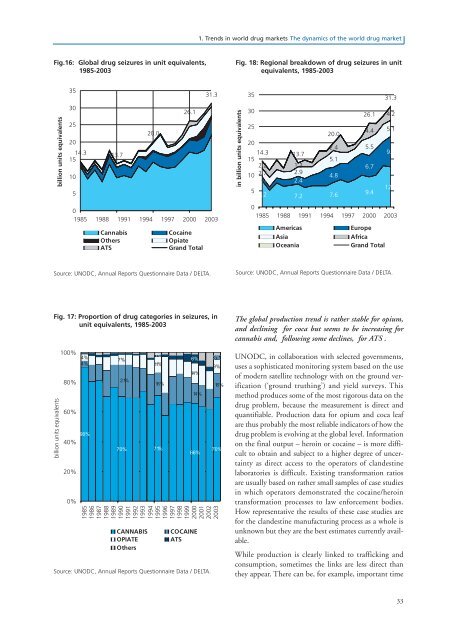World Drug Report 2005 - United Nations Office on Drugs and Crime
World Drug Report 2005 - United Nations Office on Drugs and Crime
World Drug Report 2005 - United Nations Office on Drugs and Crime
You also want an ePaper? Increase the reach of your titles
YUMPU automatically turns print PDFs into web optimized ePapers that Google loves.
1. Trends in world drug markets The dynamics of the world drug market<br />
Fig.16: Global drug seizures in unit equivalents,<br />
1985-2003<br />
Fig. 18: Regi<strong>on</strong>al breakdown of drug seizures in unit<br />
equivalents, 1985-2003<br />
35<br />
31.3<br />
35<br />
31.3<br />
billi<strong>on</strong> units equivalents<br />
30<br />
25<br />
20<br />
14.3 13.7<br />
15<br />
10<br />
5<br />
20.0<br />
26.1<br />
in billi<strong>on</strong> units equivalents<br />
30<br />
25<br />
20<br />
14.3<br />
15<br />
2.2<br />
10 2.7<br />
1.1<br />
5<br />
8.2<br />
13.7<br />
1.3<br />
2.9<br />
2.4<br />
7.2<br />
20.0<br />
2.4<br />
5.1<br />
4.8<br />
7.6<br />
26.1<br />
4.4<br />
5.5<br />
6.7<br />
9.4<br />
4.2<br />
5.1<br />
9.4<br />
12.5<br />
0<br />
1985 1988 1991 1994 1997 2000 2003<br />
Cannabis<br />
Cocaine<br />
Others<br />
Opiate<br />
ATS<br />
Gr<strong>and</strong> Total<br />
0<br />
1985 1988 1991 1994 1997 2000 2003<br />
Americas<br />
Europe<br />
Asia<br />
Africa<br />
Oceania<br />
Gr<strong>and</strong> Total<br />
Source: UNODC, Annual <str<strong>on</strong>g>Report</str<strong>on</strong>g>s Questi<strong>on</strong>naire Data / DELTA.<br />
Source: UNODC, Annual <str<strong>on</strong>g>Report</str<strong>on</strong>g>s Questi<strong>on</strong>naire Data / DELTA.<br />
Fig. 17: Proporti<strong>on</strong> of drug categories in seizures, in<br />
unit equivalents, 1985-2003<br />
billi<strong>on</strong> units equivalents<br />
100%<br />
4%<br />
4%<br />
80%<br />
60%<br />
90%<br />
40%<br />
20%<br />
0%<br />
7%<br />
21%<br />
1%<br />
11%<br />
16%<br />
70% 71%<br />
6% 3%<br />
14%<br />
14%<br />
66%<br />
9%<br />
16%<br />
70%<br />
1985<br />
1986<br />
1987<br />
1988<br />
1989<br />
1990<br />
1991<br />
1992<br />
1993<br />
1994<br />
1995<br />
1996<br />
1997<br />
1998<br />
1999<br />
2000<br />
2001<br />
2002<br />
2003<br />
CANNABIS<br />
OPIATE<br />
Others<br />
COCAINE<br />
ATS<br />
Source: UNODC, Annual <str<strong>on</strong>g>Report</str<strong>on</strong>g>s Questi<strong>on</strong>naire Data / DELTA.<br />
The global producti<strong>on</strong> trend is rather stable for opium,<br />
<strong>and</strong> declining for coca but seems to be increasing for<br />
cannabis <strong>and</strong>, following some declines, for ATS .<br />
UNODC, in collaborati<strong>on</strong> with selected governments,<br />
uses a sophisticated m<strong>on</strong>itoring system based <strong>on</strong> the use<br />
of modern satellite technology with <strong>on</strong> the ground verificati<strong>on</strong><br />
(‘ground truthing’) <strong>and</strong> yield surveys. This<br />
method produces some of the most rigorous data <strong>on</strong> the<br />
drug problem, because the measurement is direct <strong>and</strong><br />
quantifiable. Producti<strong>on</strong> data for opium <strong>and</strong> coca leaf<br />
are thus probably the most reliable indicators of how the<br />
drug problem is evolving at the global level. Informati<strong>on</strong><br />
<strong>on</strong> the final output – heroin or cocaine – is more difficult<br />
to obtain <strong>and</strong> subject to a higher degree of uncertainty<br />
as direct access to the operators of cl<strong>and</strong>estine<br />
laboratories is difficult. Existing transformati<strong>on</strong> ratios<br />
are usually based <strong>on</strong> rather small samples of case studies<br />
in which operators dem<strong>on</strong>strated the cocaine/heroin<br />
transformati<strong>on</strong> processes to law enforcement bodies.<br />
How representative the results of these case studies are<br />
for the cl<strong>and</strong>estine manufacturing process as a whole is<br />
unknown but they are the best estimates currently available.<br />
While producti<strong>on</strong> is clearly linked to trafficking <strong>and</strong><br />
c<strong>on</strong>sumpti<strong>on</strong>, sometimes the links are less direct than<br />
they appear. There can be, for example, important time<br />
33

















